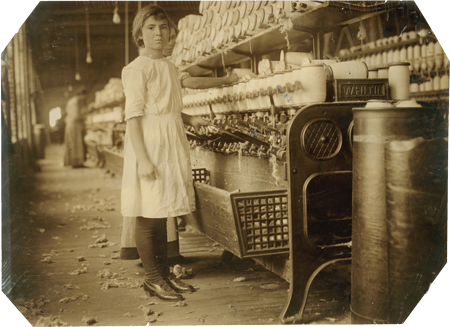
Cotton Mills of the Jones Falls

Girl winding yarn onto shuttle quills, c. 1910, photo by Lewis Wickes Hine
(Library of Congress)
Steps in Milling Cotton
Though similar, Steps in Milling Cotton is organized by the order of the processes, while Automating Cotton is organized in order of technological progress.
After cotton is grown and picked (for more information on picking cotton, see Cotton Harvesting), it is shipped to a mill. Below are the steps required to clean cotton, turn it into yarn, then weave it into cotton duck.
The term “duck” comes from the Dutch word doek, which refers to a linen canvas once used for sailors’ white trousers and outerwear. Cotton duck is the same material, but woven from cotton (What Is Duck Cloth?).
Sylvia DeMar demonstrates removing cotton seeds from raw cotton by hand. Art League School, Alexandria, Virginia
Carding is necessary to smooth out and remove lumps from the raw cotton.
Sylvia DeMar demonstrates spinning — creating yarn from raw cotton — using a traditional spinning wheel. The spinner stretches out a uniform amount of cotton while spinning wheel twists the cotton fibers, giving them strength. Art League School, Alexandria, Virginia
The steps are:
- Picking — A 500-pound bale of cotton is opened, run through a cotton gin to remove the seeds, and cleaned. Cleaning could be the most dangerous operation because cotton was sold by the pound, and slaves might add rocks to make their quota or unscrupulous plantation owners might add rocks to the cotton bale to increase its value.
- Carding — Impurities are removed from cotton fibers and lumps are removed using two wire brushes. The carded cotton is turned into a “rolag” if it’s hand-carded or a rope-sized “sliver” if it's machine-carded
- Drawing — Long slivers of combed cotton are stretched and combined
- Roving — Slivers are “drawn out” — lengthened still further — and given a slight twist to make roving, a very large, loose form of yarn
- Spinning — The roving is further stretched, given a hard twist to lock the fibers together, then it is wound as yarn onto bobbins. To strengthen it, two, three or more yarns may be spun together. (The number of yarns spun together is referred to as “ply” — 2-ply, 3-ply, etc.)
- Dressing — The strong warp yarn is coated with a hot, starchy solution to further strengthen it. Dressing can also prevent chaffing in the reeds (see Weaving, below) of the power loom. (You do not want to over-dress the yarn when making sails, as the dressing is ideal media for growing mildew, which leads to rot; early power looms could not make strong enough sail cloth without using more dressing than could be removed in Finishing.)
- Warping and Drawing-in — The warp yarn is wound onto a beam which is fitted into the loom, then the individual yarns are threaded through the loom heddles in a process known as “drawing-in.” Different heddles allow one set of warp yarns — commonly every other one — to be pulled up for the first pass of the shuttle, and then the other set to be pulled up for the next pass, alternating each time. More intricate patterns can be woven using more heddles.
- Weaving — Takes place in 5 motions:
- A length of warp yarn is let off the warp beam
- The heddles lifts some of the warp yarns, creating a shed — a triangular space between the raised and unraised warp yarns.
- The filling yarn is drawn through the shed by a shuttle.
- In a traditional shuttle loom, the filling yarn is wound onto a quill (a device like a spindle), which in turn is mounted in the shuttle. The shuttle is passed through the shed by hand, and the filling yarn is pulled off the quill and out of the shuttle, leaving a trail of yarn.
- In the “flying shuttle,” the shuttle is thrown from one side to the other using levers rather than being passing by hand. This increases both the speed at which the shuttle travels and the width of cloth that can be woven. Previously, cloth could not be much wider than twice the length of the weaver’s forearm (approximately a yard).
- Between the heddles and the take-up roll, the warp threads pass through another frame called the reed (which resembles a comb). After the shuttle moves across the loom laying down the fill yarn, the weaver uses the reed to press (or batten) the filling yarn against the “fell” — the portion of the fabric that has already been formed but not yet rolled up on the take-up roll.
- The finished cloth is taken up onto a cloth roll.
- Finishing — The cloth is bleached to remove the dressing, dyed, printed, inspected for faults, and its edges are trimmed.
- Baling — The cloth is pressed into bolts in preparation for shipping. A bolt is a unit of measure of cloth; cotton duck is often 42" or 60" wide and anywhere from 30–100 yds long (The Milling Process).
There are two types of thread or yarn used to weave — the “warp” yarn and the “woof” or “weft” yarn. The warp yarn is placed on the loom and pulled through as the weaving progresses, and the softer weft yarn is woven across to make the fabric. The warp yarn must be stronger than the softer weft yarn to withstand the stretching and pulling of the loom's heddles without breaking.